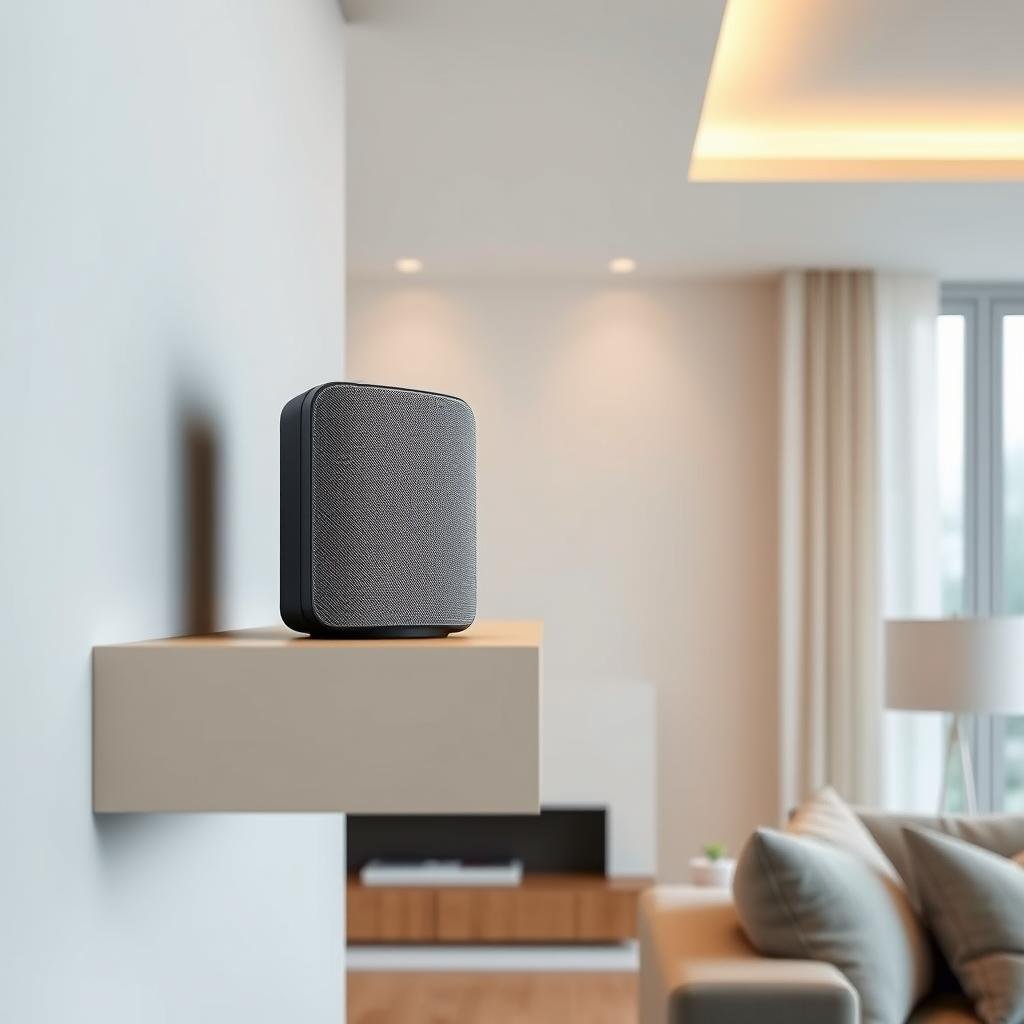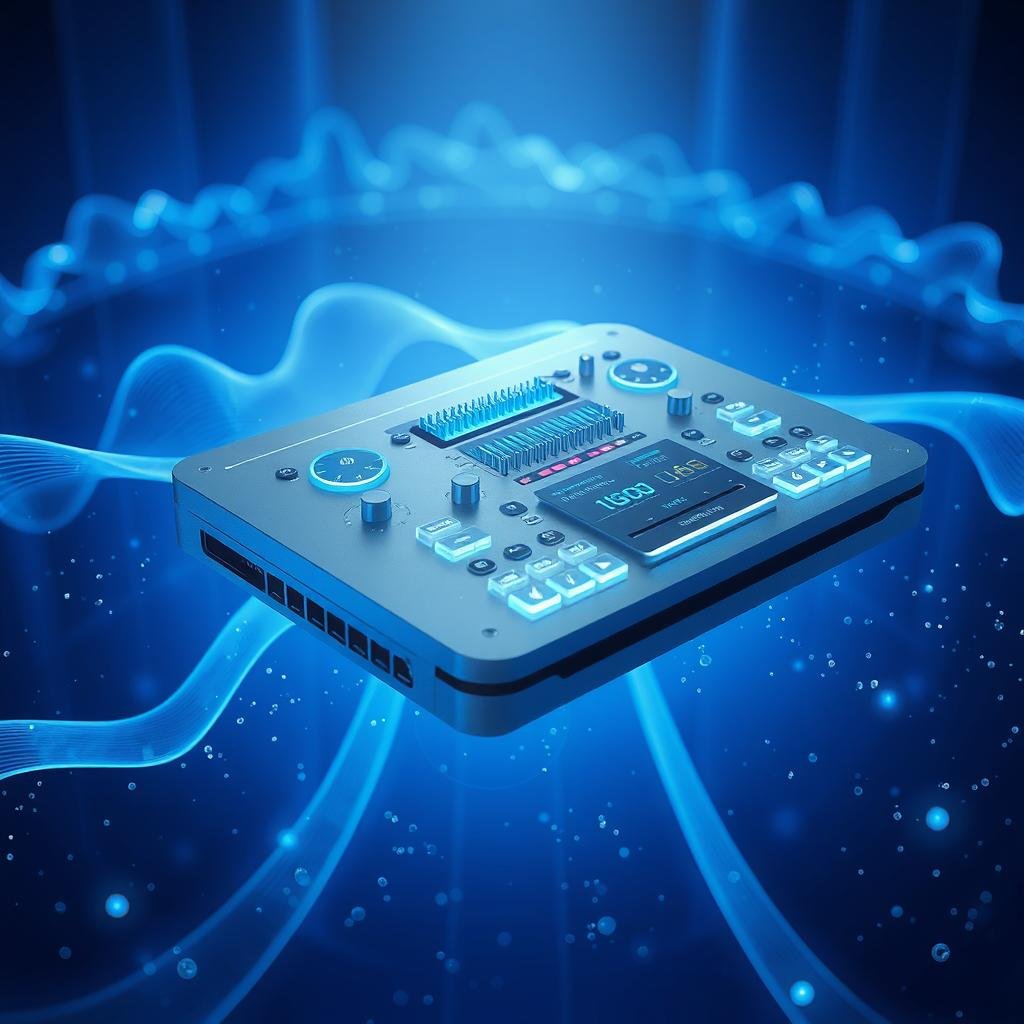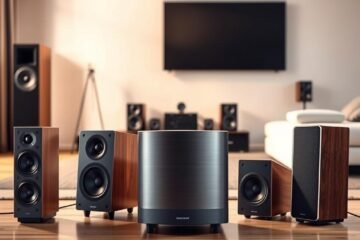Did you know that over 76% of American households now own at least one voice-controlled device? This shows how these gadgets have changed our daily lives.
Your home can become a connected hub where voice assistants do your bidding. These smart devices bring Alexa, Google Assistant, and Siri into your space. They control lights, play music, and answer questions fast.
The year 2025 is a pivotal moment for smart audio tech. With better AI and connectivity, these devices are more vital than ever. PCMag started reviewing smart speakers in 2015, and the tech has grown a lot.
These voice-controlled systems make homes smarter. They boost productivity, entertainment, and automation like never before.
In 2025, smart audio technology is more immersive, intelligent, and user-friendly than ever. Whether you’re looking to upgrade your home entertainment, enjoy high-quality wireless sound on the go, or simply add voice-controlled convenience to your space, this smart audio gadgets guide 2025 is here to help. We’ve picked the best smart speakers, noise-cancelling earbuds, multi-room sound systems, and portable Bluetooth devices.
Plus, you’ll find expert tips on how to choose the right gadget for your lifestyle, budget, and audio needs.
Looking to upgrade your setup? Explore our budget-friendly smart audio gadgets,
Key Takeaways
- Voice-controlled devices are now present in over three-quarters of American homes
- Modern intelligent speakers integrate with major voice assistants including Alexa, Google Assistant, and Siri
- Advanced AI and connectivity improvements make 2025 a breakthrough year for adoption
- Expert reviews have tracked the evolution from the original Amazon Echo in 2015
- These devices create connected home ecosystems that enhance daily productivity and entertainment
- Voice-controlled technology seamlessly integrates with existing home automation systems
Understanding Smart Audio Gadgets in Today’s Connected World
Today, our world is more connected than ever. Smart home audio gadgets are key to this connection. They mix convenience with the latest tech.
These devices are more than just speakers. They use AI and voice recognition to become smart assistants. Your home can now respond to your voice.
What Are Smart Audio Gadgets
Smart audio devices are smart speakers that connect to your home network. They respond to voice commands. They play music, answer questions, and control other devices in your home.
They come with built-in voice assistants like Alexa, Google Assistant, or Siri. They connect to the internet through Wi-Fi or Bluetooth. This lets them access streaming services and smart home controls.
These devices do more than play music. They act as central hubs for your smart home. You can control lighting, thermostats, and security systems with your voice.
See all our best headphone picks here
Examples of Voice-Controlled Audio Devices
Voice-controlled audio devices meet different needs and fit various spaces. Smart speakers like Amazon Echo and Google Nest are very popular. They sit on countertops or shelves.
Wireless earbuds with AI offer personal audio experiences. Apple AirPods Pro and Samsung Galaxy Buds have voice activation and smart noise cancellation. They let you control music and calls with your voice.
Smart soundbars enhance your TV experience with voice control. Sonos Arc and Bose Smart Soundbar connect to your TV and streaming services. They let you control volume and content with your voice.
Multi-room audio systems spread sound across your home. They include multiple speakers that work together. You can control each room or create a whole-home audio experience.
| Device Type | Primary Function | Voice Assistant | Connectivity |
|---|---|---|---|
| Smart Speakers | Music playback and home control | Alexa, Google Assistant, Siri | Wi-Fi, Bluetooth |
| Wireless Earbuds | Personal audio and calls | Siri, Google Assistant | Bluetooth, wireless charging |
| Smart Soundbars | TV audio enhancement | Alexa, Google Assistant | Wi-Fi, HDMI, optical |
| Multi-room Systems | Whole-home audio distribution | Multiple options | Wi-Fi mesh network |
Why Smart Audio Devices Are More Relevant Than Ever in 2025
In 2025, smart audio devices are more important than ever. They’ve become smarter thanks to AI and voice recognition. Now, talking to your devices feels more natural and responsive.
New tech like Matter and Thread has made devices work better together. Your smart speakers can now talk to any smart home device, no matter the brand. This means no more compatibility issues.
These devices can understand context and follow-up questions. You can have real conversations, not just robotic commands. They even recognize different voices and give personalized answers.
These devices are also better for the environment. They use less power but perform better. They adjust their power use based on how much you use them.
Streaming services work better with these devices now. You can stream high-quality audio and switch between services like Spotify and Apple Music with your voice.
Privacy and security have also improved. These devices use better encryption and local processing to keep your data safe. Many offer physical privacy switches and clear data policies.
Key Benefits of Using Smart Audio Gadgets in 2025
Smart audio gadgets in 2025 bring big changes to how we use technology and live in our homes. They’ve grown from just playing music to being smart helpers that make our daily lives better. Today’s smart speakers have advanced AI, many ways to connect, and work well with all your digital stuff.
These gadgets offer three main benefits for a smarter, more connected life. You get to talk naturally to them, control your whole home with your voice, and enjoy music that fits your mood.

Enhanced Voice-Controlled Audio Experiences
Voice-controlled speakers in 2025 get what you’re saying and respond in a smart way. You can talk like you’re talking to a friend without using special commands. They know your voice, remember what you like, and give you answers based on what you’ve listened to before.
The latest smart speakers can have long conversations with you. You can ask questions, change topics, and get answers without repeating yourself. This makes controlling your music and other audio easy and natural.
They also have advanced noise cancellation and microphones that hear you even when it’s loud. Your voice commands are understood right away, whether you’re playing music, changing the volume, or asking for a specific song.
Seamless Smart Home Integration
Smart home integration makes your audio devices the center of your connected home. Modern smart speakers work with Zigbee, Matter, and Thread, so you can control lights, thermostats, cameras, and locks without extra hubs.
You can set up smart routines that play music and control your home at the same time. For example, saying “Good morning” can start your morning playlist while turning on the lights, adjusting the temperature, and giving you the weather. These routines save time and make your day smoother.
Some smart speakers even have temperature sensors and motion detection. They learn your preferences and adjust the room’s temperature and lighting for you, keeping the music perfect everywhere in your home.
Improved Audio Streaming and Connectivity
Audio streaming services now offer high-quality formats like lossless audio and spatial sound. These formats give you music that sounds just like the studio, with all the details and sound placement you’d expect. You get to hear music exactly as the artists intended.
Multi-room sync lets you play music all over your house without skipping a beat. You can start music in one room and it follows you to others. The advanced tech makes sure the audio stays perfect everywhere.
AI-powered music curation picks music based on what you like, your mood, and what you’re doing. Your smart speakers learn when you want upbeat music or something more relaxing. They create personalized soundtracks for different times and activities.
| Benefit Category | Key Features | User Impact | 2025 Improvements |
|---|---|---|---|
| Voice Control | Natural conversation, contextual awareness, voice recognition | Effortless interaction, personalized responses | Multi-turn conversations, emotion detection |
| Home Integration | Zigbee/Matter support, automation routines, sensor integration | Centralized control, seamless daily routines | Proactive environmental optimization |
| Audio Quality | Lossless streaming, spatial audio, multi-room sync | Studio-quality sound, whole-home coverage | AI-powered curation, adaptive audio processing |
| Connectivity | Wi-Fi 6E, Bluetooth 5.3, mesh networking | Reliable connections, extended range | Ultra-low latency, automatic network optimization |
These benefits make smart audio gadgets key parts of modern homes. They offer smart audio experiences that fit your life and make daily tasks easier with voice control and seamless device integration.
How to Choose the Right Smart Audio Gadget for Your Needs
Finding the right wireless audio gadgets for your home is more than just sound quality. You need to think about your needs, your home, and how these devices fit into your daily life.
Choosing wisely means looking at your space, budget, and what you need in a smart audio system.
Assess Your Living Space and Lifestyle
Your home’s size and sound quality matter a lot. Room size and acoustics affect how well devices sound.
Big, open spaces need strong speakers for good sound. Smaller areas do well with smaller gadgets that focus sound better.
Think about how you’ll use these devices. Do you need them to move around or stay in one place? Will you use them for music, voice commands, or both?
Determine Essential Features and Budget
Smart audio devices vary in features and price. Prioritizing your must-have features helps you choose.
Basic features include Bluetooth, voice control, and music streaming. More advanced options might include spatial audio, multi-room sync, or smart home features.
Battery life is key for portable devices. Think about how often you’ll use them and if they need constant charging.
Sound quality is personal. Some like deep bass for music, while others need clear voice for calls and commands.
| Budget Range | Expected Features | Best Use Cases | Typical Device Types |
|---|---|---|---|
| $50-$100 | Basic voice control, Bluetooth, Wi-Fi | Single room, casual listening | Compact smart speakers |
| $100-$300 | Enhanced audio, multi-room, smart home integration | Multiple rooms, home automation | Premium speakers, soundbars |
| $300-$500 | High-fidelity audio, advanced AI, premium materials | Audiophile listening, whole-home systems | Premium speakers, wireless headphones |
| $500+ | Professional audio, custom installation, luxury features | Home theaters, professional setups | Multi-room systems, high-end equipment |
Consider Voice Assistant Compatibility
Voice assistant compatibility is key for long-term use and adding more devices. Your choice of Amazon Alexa, Google Assistant, or Apple Siri sets up your smart home.
Amazon Alexa has the most compatible devices and skills. It works well with many smart home products and has lots of third-party integrations.
Google Assistant is great at answering questions and works well with Google services. It has top-notch voice recognition for complex queries.
Apple Siri is best for iPhone and Mac users. It focuses on privacy and works well within Apple’s ecosystem, though it has fewer third-party integrations.
Think about your current devices and services. If you use Gmail, Google Photos, or Android, Google Assistant is a good choice. iPhone users might prefer Siri for better integration.
Plan for future additions. Choosing a voice assistant ecosystem now helps you add devices later without compatibility problems.
Some devices support multiple voice assistants, giving you flexibility to switch or use different assistants for different tasks.
Privacy is also important when picking voice recognition technology. Look into each assistant’s data collection and privacy controls to make a smart choice.
Top 5 Categories of Smart Audio Gadgets in 2025
Modern audio technology has evolved into five key categories. These categories transform your listening experience across every aspect of home and mobile entertainment. They represent the pinnacle of smart audio innovation, each designed to address specific needs and preferences in today’s connected world.
Understanding these categories helps you make informed decisions about which smart audio solutions align with your lifestyle. Each category offers unique features and capabilities that enhance different aspects of your daily audio consumption.

Smart Speakers and Voice Assistants
Smart speakers serve as the foundation of modern connected homes. They combine powerful audio output with intelligent voice recognition technology. These devices range from compact bedside units to room-filling powerhouses that act as central command centers for your entire smart home ecosystem.
Voice assistants integrated into these speakers respond to natural language commands. You can control music playback, adjust volume, and manage connected devices hands-free. Advanced models feature adaptive audio that automatically adjusts sound based on room acoustics and ambient noise levels.
The latest smart speakers support multiple streaming services and can seamlessly switch between different audio sources. They also provide real-time weather updates, news briefings, and smart home device control through simple voice commands.
Want to take your audio experience to the next level? Check out our best smart speakers of 2025,
Wireless Earbuds and Audio Wearables
The wireless earbuds market has exploded with innovations that go far beyond basic audio playback. Modern wireless earbuds incorporate advanced features like adaptive transparency modes, spatial audio processing, and intelligent device switching that automatically connects to your most active device.
Health monitoring capabilities have become standard in premium wireless earbuds. They track heart rate, step count, and even stress levels during workouts. These wearable audio devices seamlessly integrate with fitness apps and provide real-time coaching through personalized audio feedback.
Noise-canceling headphones represent the premium segment of this category. They use sophisticated algorithms to eliminate unwanted ambient sound. Top-tier noise-canceling headphones now feature AI-powered adaptive sound that learns your listening preferences and automatically adjusts audio profiles based on your environment.
Smart Soundbars and Home Theater Systems
Smart soundbars have revolutionized home entertainment by delivering cinema-quality audio experiences. They support Dolby Atmos technology, creating immersive three-dimensional soundscapes. This makes movie nights feel like theater experiences.
Voice control integration allows you to adjust audio settings, switch between different sound modes, and control connected streaming devices using simple spoken commands. Many smart soundbars automatically calibrate their audio output based on room dimensions and furniture placement.
Advanced models feature wireless subwoofers and satellite speakers that create true surround sound without running cables throughout your living space. These systems integrate seamlessly with popular streaming platforms and gaming consoles.
Multi-Room Audio Systems
Multi-room audio systems enable you to create synchronized music experiences throughout your entire home. Each room functions as an independent audio zone or part of a larger connected network. These systems use wireless connectivity to eliminate the need for complex wiring installations.
App-based control interfaces allow you to manage different audio sources in each room simultaneously. You can play jazz in the kitchen while streaming podcasts in the office and enjoying classical music in the bedroom, all controlled from a single smartphone application.
Zone-based audio management lets you group rooms together for parties or events. This creates a unified sound experience across multiple spaces. Premium multi-room audio systems support high-resolution audio formats and can stream from multiple sources simultaneously without quality degradation.
| Category | Primary Use Case | Key Features | Price Range |
|---|---|---|---|
| Smart Speakers | Voice control and smart home hub | Voice assistants, smart home integration | $50 – $400 |
| Wireless Earbuds | Portable personal audio | Noise cancellation, health tracking | $100 – $500 |
| Smart Soundbars | Home theater enhancement | Dolby Atmos, voice control | $200 – $1,200 |
| Multi-Room Systems | Whole-home audio distribution | Wireless connectivity, zone management | $300 – $2,000 |
Each category addresses different aspects of modern audio consumption. Your choice depends on your specific needs, living situation, and budget considerations.
Complete Smart Audio Gadgets Guide 2025: Premium Smart Speakers
Advanced smart speakers blend top-notch audio engineering with ai-powered audio assistants. They offer unmatched performance. These devices are the top of the line in smart audio tech, providing great sound and smart home integration.
The best smart speakers 2025 market shows big leaps in tech. These speakers now give you studio-quality sound and fast voice recognition. They also control your smart home easily.
Ready to enhance your sound setup? Discover our Bluetooth speakers with the best battery life,
Amazon Echo Studio – Best Overall Smart Speaker
Product Highlight: The Amazon Echo Studio leads with its five-driver setup and 360-degree sound.
Features & Technologies: It has 5.1 surround sound with Dolby Atmos. It has three 2-inch midrange speakers, one 1-inch tweeter, and a 5.25-inch woofer. It also has room adaptation tech for perfect sound in any space.
Voice Assistant Compatibility: Alexa makes it easy to control your smart home and use voice commands. It supports multi-room audio and Drop In for talking to everyone at home.
Battery Life & Connectivity: It needs AC power and has Wi-Fi, Bluetooth, and optical inputs. It also has a Zigbee hub for easy smart device connection.
Best For: It’s perfect for those who love great sound and smart home features in one.
Pros: Amazing spatial audio, built-in smart home hub, great value
Cons: Big size, needs a wall outlet, not portable
Price Range: $199
Google Nest Audio Max – Best Voice-Controlled Speaker
Product Highlight: The Google Nest Audio Max is top for voice control with Google Assistant and great sound.
Features & Technologies: It has balanced sound with clear vocals and detailed highs. It has fast voice command processing and sound that adjusts to noise levels.
Voice Assistant Compatibility: Google Assistant is very accurate and works well with Google services. It also streams audio easily with Chromecast built-in.
Battery Life & Connectivity: It uses AC power and has Wi-Fi and Bluetooth. It works with other Google Nest speakers for multi-room audio.
Best For: It’s great for those in the Google ecosystem who want accurate voice control and smart home features.
Pros: Top voice recognition, Google services integration, balanced sound
Cons: Less bass than others, limited smart home hub
Price Range: $179-$199
These premium smart speakers offer immersive sound experiences and control your connected home. Both are excellent choices for top audio quality and smart voice control.
Top Wireless Earbuds and Noise-Canceling Headphones for 2025
Smart earbuds and noise-canceling headphones are top-notch this year. They offer great sound quality and smart features. These audio wearables have become key smart devices, not just for music.
They now track your health, control your voice, and adjust sound based on where you are. This makes them essential for daily life.
The battle among wireless audio brands is fierce in 2025. Companies focus on battery life, sound quality, and smart features. Wearable audio devices do more than play music now.

Apple AirPods Pro 3rd Generation – Best Wireless Earbuds
Apple’s AirPods Pro 3rd Generation lead in wireless audio innovation. They have adaptive transparency mode that adjusts to your environment. This lets you hear important sounds while blocking out the rest.
They offer personalized spatial audio for an immersive experience. The iPhone’s TrueDepth camera creates a custom sound profile based on your ear shape. This makes every song and podcast sound better.
The battery life is impressive, lasting up to 6 hours per charge. The MagSafe charging case adds 24 more hours. Quick charging gives you 1 hour of listening with just 5 minutes in the case.
Siri works seamlessly without needing “Hey Siri.” Just nod or shake your head to respond. This makes them perfect for workouts and busy days.
Sony WH-1000XM6 – Best Noise-Canceling Headphones
Sony’s WH-1000XM6 lead in noise-canceling technology. They use dual noise sensors to capture sound from all angles. This results in better noise elimination than before.
The battery lasts 30 hours with noise canceling on. Quick charge gives 3 hours of playback with just 3 minutes. These wearable audio devices keep you connected all day.
Multipoint Bluetooth lets you connect to two devices at once. Switch between your laptop and phone easily. The headphones pause music when you get a call.
AI sound optimization learns your music preferences. The Headphones Connect app adjusts the sound based on your choices. Speak-to-chat technology pauses music when you start talking.
They’re comfortable with soft leather ear cushions and a lightweight design. The adjustable headband makes them comfortable for long use. They fold flat for easy storage.
Best Smart Soundbars and Multi-Room Audio Systems
Today’s wireless speakers and soundbars make it easy to create amazing audio environments at home. They turn regular rooms into entertainment centers that feel like movie theaters.
These smart home audio systems offer great flexibility and control. You can play music in many rooms at once or focus it in one area. They even work with voice commands and adjust to your room’s acoustics.

Sonos Arc Ultra – Premium Smart Soundbar
The Sonos Arc Ultra is a top-notch smart sound bar. It has eleven drivers for clear sound and deep bass. It also creates Dolby Atmos effects that make you feel like you’re right in the action.
Voice control integration works with Alexa and Google Assistant. You can change volume, content, or control other smart devices with just your voice. It automatically adjusts sound for your room’s acoustics.
Setting it up is quick and easy. It connects wirelessly to your TV and adjusts audio settings for your room. You get cinema-quality sound without the hassle of complex wiring or professional setup.
Bose SoundTouch 30 – Multi-Room Audio Excellence
The Bose SoundTouch 30 is great for setting up smart home audio systems in your whole house. These wireless speakers work well together across rooms, giving you the same sound everywhere.
The mobile app lets you control multiple rooms at once. You can play different music in each room or sync them all for a big party. Preset buttons make it easy to access your favorite streaming services.
It connects via Wi-Fi and Bluetooth for reliable streaming. This keeps the sound quality high, even in big homes with tricky layouts.
Multi-room synchronization works well across different levels and rooms. You can start music in the kitchen and it follows you to the living room or bedroom without skipping a beat.
AI Music Players and Futuristic Audio Technology
Futuristic audio technology, powered by artificial intelligence, is changing the world of smart sound. These devices learn your preferences and adjust to your surroundings. AI music players are at the forefront of personalized audio.
Machine learning algorithms in these devices analyze your listening habits in real-time. They consider room acoustics, time of day, and mood to offer the best sound. This intelligence changes how we enjoy music and audio.
Advanced audio processing lets these devices adjust sound automatically. They can boost bass for movies or enhance vocals for podcasts. This creates a customized audio experience that grows with you.

“The future of audio is not just in better speakers, but in smarter ones that understand and meet our needs.”
Predictive playlist curation is another big step in audio ai technology. These systems suggest new music based on your listening patterns. They consider weather, activity, and past preferences to create the perfect soundtrack for your day.
Building your ultimate smart audio collection? Start with our smart audio gadgets with AI features,
Bang & Olufsen Beosound A1 – AI-Powered Audio Assistant
The Bang & Olufsen Beosound A1 is a top example of futuristic audio technology. It combines Danish design with advanced AI. Its small size doesn’t mean it lacks features.
The device’s AI engine keeps track of your listening habits and preferences. It adjusts sound based on room size, materials, and noise levels. This smart adaptation ensures great sound no matter where you place it.
Voice assistant integration makes the Beosound A1 a true audio partner. You can control it, adjust settings, and get music recommendations with voice commands. It learns your speech and preferences over time.
Premium materials and craftsmanship set this device apart from regular smart speakers. The aluminum build is durable and elegant. Portable design lets you enjoy AI-enhanced audio anywhere.
Battery life is up to 18 hours, perfect for outdoor use or long listening sessions. It’s also waterproof, ensuring reliable performance in various settings. These features complement its advanced audio ai capabilities.
The future of ai music players is in devices like the Beosound A1. They blend premium audio engineering with smart software. As these technologies improve, we’ll see even more personalized and intuitive audio experiences.
Smart Audio Gadgets Comparison Table and Buying Guide
Finding the right smart audio gadget is easier with detailed comparisons. This guide breaks down key features, prices, and performance. You’ll see which devices offer the best value and which premium features are worth the extra cost.
Smart audio tech changes fast, so making smart choices is key. We’ve analyzed real-world data and user feedback to help you choose.
Side-by-Side Feature Comparison
Knowing the specs helps you find the right device for you. This comparison shows the strengths and weaknesses of top devices in each category.
| Device Category | Voice Assistant | Connectivity | Audio Quality | Smart Home Integration |
|---|---|---|---|---|
| Premium Smart Speakers | Alexa, Google, Siri | Wi-Fi, Bluetooth 5.0 | 360° spatial audio | Full ecosystem support |
| Wireless Earbuds | Siri, Google Assistant | Bluetooth 5.3, ANC | Adaptive EQ, Hi-Res | Limited integration |
| Smart Soundbars | Built-in assistants | Wi-Fi, HDMI eARC | Dolby Atmos, DTS:X | TV and streaming control |
| Multi-Room Systems | Platform dependent | Wi-Fi mesh, Ethernet | Synchronized playback | Whole-home automation |
There are big differences in what each category offers. Premium smart speakers are great for voice control and smart home use. Wireless earbuds focus on portability and sound quality.
Smart soundbars are all about immersive audio experiences for your entertainment setup. Multi-room systems cover your whole home with synchronized sound.
Price Range Analysis for Each Category
When choosing, budget is important. Knowing the price ranges helps you find the best deal for your needs.
Budget Tier ($50-$150): This range has entry-level smart speakers and basic earbuds. They offer decent voice control and sound but lack premium features.
Mid-Range ($150-$300): Here, you find great bluetooth speakers for home use with better sound processing. Most people find the best value here.
Premium Tier ($300-$600): High-end devices have advanced noise cancellation, better drivers, and full smart home integration. They offer top-notch audio quality for the price.
Ultra-Premium ($600+): These top products showcase the latest tech and materials. They’re for audiophiles and smart home fans looking for the best experience.
The mid-range category offers the best mix of features and price for most users.
Best Smart Speakers 2025 Recommendations
Current audio gadget trends shape the best future-proof choices. These picks focus on performance, features, and long-term value.
Best Overall Value: Amazon Echo Studio is a top pick. It offers great sound and smart home control. Its 360-degree sound and Dolby Atmos make it stand out.
Best for Google Users: Google Nest Audio Max is perfect for Google fans. It has top voice recognition and works well with smart home devices.
Best Premium Choice: Bang & Olufsen Beosound A1 is a luxury choice. It has AI-powered sound and a sleek design. It automatically adjusts to your listening preferences.
Think about your current smart home setup when deciding. Make sure the device works well with your existing systems for the best experience.
Smart Audio Gadget Trends to Watch in 2025
Smart audio tech is moving fast in 2025, bringing new ideas into our daily lives. The field is shifting towards smarter, more personal, and integrated audio experiences. These changes will change how we enjoy sound at home, work, and on the move.
Emerging Audio Gadget Trends
Augmented audio reality is a big deal in smart audio tech. It adds digital sound to your real world. You can hear sounds that change as you move around.
This tech uses spatial audio mapping for immersive sounds. Your speakers adjust the sound based on where you are. It makes listening feel like you’re in a three-dimensional world.
Biometric audio security is changing how we keep our audio devices safe. It uses your voice and ear shape for security. It checks over 100 voice traits to make your audio fingerprint.

Adaptive soundscaping adjusts your audio based on your day. It learns your routine and changes the sound quality. Morning podcasts get clearer, and evening music gets warmer.
Wearable Audio Devices and Audio AI Advances
Wearable audio tech is growing beyond headphones and earbuds. Smart jewelry and audio glasses let you hear calls and messages without blocking your ears.
Clothing with built-in audio is also coming. It uses bone conduction to send sound through fabric. This means you can listen without anyone seeing your earbuds.
Artificial intelligence in audio devices now does real-time language translation. Your earbuds can translate speech instantly. They also understand emotions through voice analysis, adjusting their responses.
Predictive audio recommendations are getting smarter in 2025. Your voice-controlled devices guess what you’ll want to listen to. They learn from your habits to suggest music before you ask.
Future of Voice-Controlled Devices
The next wave of voice-controlled devices will talk like humans. They understand context, remember conversations, and act like assistants. They can even recognize different users in your household.
Ambient computing makes voice control invisible and easy. Your home becomes a smart space that responds to voice commands from anywhere. You won’t need to say “Hey, Alexa” to start talking.
Augmented audio reality will soon work with voice commands. You can control virtual sounds with your voice. This creates immersive audio worlds where digital and real sounds mix.
If you’re searching for the perfect upgrade, don’t miss our smart audio gadgets with AI features
| Technology Trend | Key Features | Expected Timeline | Impact Level |
|---|---|---|---|
| Augmented Audio Reality | Spatial sound mapping, location-based audio | Mid-2025 | High |
| Biometric Audio Security | Voice patterns, ear canal authentication | Late 2025 | Medium |
| Smart Wearable Audio | Jewelry speakers, audio-enabled clothing | Early 2025 | High |
| Ambient Voice Control | Natural conversations, multi-user recognition | Throughout 2025 | Very High |
These technologies will make audio experiences magical yet natural. Biometric audio security will keep your data safe while giving you easy access. Voice-controlled systems will feel like talking to a smart friend.
These trends are just the start of smart audio’s evolution. As AI gets better, your devices will get smarter and more personal. The future holds audio experiences that fit your life perfectly.
Expert Tips for Buying and Using Smart Audio Gadgets
To get the most from your smart audio, you need to know how to set it up and optimize it. Your journey to amazing immersive sound experiences starts with planning. It continues with fine-tuning your devices.
Smart audio tech has grown fast, giving us great convenience and quality. But many users don’t use all their devices’ features. Knowing how to set up, place, and configure your devices is key to getting the best performance.

Creating Your Perfect Audio Environment
Building great smart home audio systems starts with analyzing your room and placing devices wisely. Your room’s acoustics are key to sound quality, no matter how good your equipment is.
Put your main speakers at ear level when you sit in your favorite listening spot. Avoid corners or walls for bass. Hard surfaces reflect sound, while soft ones absorb it.
Good network infrastructure is vital for smart audio. Make sure your Wi-Fi covers all your audio zones well. For big homes, consider mesh networks.
When integrating with smart homes, think about compatibility. Pick devices that work well with your system, like Amazon Alexa or Google Assistant.
| Setup Component | Optimal Configuration | Common Mistakes | Performance Impact |
|---|---|---|---|
| Speaker Placement | Ear level, 3-8 feet from walls | Corner placement, too high/low | Sound clarity and bass response |
| Wi-Fi Signal | -50 dBm or stronger | Relying on weak distant signals | Streaming stability and quality |
| Smart Home Hub | Central location, ethernet connected | Hidden in cabinets, Wi-Fi only | Response time and reliability |
| User Profiles | Individual preferences configured | Using default generic settings | Personalization and convenience |
Bluetooth Speaker Optimization Techniques
To get the most from Bluetooth speakers, know about codec compatibility and connection management. Modern speakers support various codecs, with aptX and LDAC being better than SBC.
Check if your source device and speakers support high-quality codecs. This can greatly improve sound quality, making music sound better.
Managing connections on multiple devices is key in busy homes. Many speakers let you pair multiple devices. But knowing how to switch between them can prevent interruptions.
Room acoustics affect Bluetooth speakers just like wired systems. Try different placements to find the best sound balance without too much bass or harsh treble.
Streaming and Voice Assistant Performance Enhancement
To optimize audio streaming services, balance quality with network capacity. Higher bitrate streams sound better but use more bandwidth. This can cause problems if your network gets busy.
Adjust streaming quality based on your network and listening habits. Use lossless formats for the best sound, but compressed formats are okay for casual listening.
Make your voice assistant better by training it well and optimizing your environment. Spend time training it, and try to reduce background noise during training.
Position voice-enabled devices away from speakers to avoid audio feedback. This can help your assistant understand your commands better.
Keep your devices updated with the latest firmware. This unlocks new features and improves performance. Enable automatic updates or check regularly for updates.
Customize your voice assistant with unique wake words and preferences. Choose wake words that don’t happen often in your daily talk. This reduces accidental activations.
Manage network bandwidth when many devices stream at once. Use Quality of Service (QoS) rules on your router to prioritize audio traffic during busy times.
Create dedicated user profiles for family members. This ensures everyone gets their own immersive sound experiences on all devices. Each profile can have its own music preferences, volume, and commands.
For those looking to improve their audio gear, explore our best eco-friendly sound solutions.
Conclusion
This smart audio gadgets guide 2025 shows how these devices change our homes. Smart speakers and voice assistants do more than play music. They manage your home and meet your daily needs.
The top-notch devices in this guide are at the forefront of audio tech. They come with special features for all kinds of lifestyles and budgets. Whether you pick the Amazon Echo Studio or Google Nest Audio Max, you get better entertainment and productivity.
Voice assistants are getting smarter, bringing AI into your living room. They learn what you like, adjust to your schedule, and offer unique audio experiences. These were once dreams, now they’re reality.
Choosing the right smart home devices is key. They should work well together. This includes multi-room audio systems, wireless earbuds, and smart soundbars. They all respond to voice commands and improve sound quality everywhere.
When picking smart audio tech, think about what you need, your space, and your budget. These devices are more than fun gadgets. They open doors to a smarter, more connected life that fits your style and improves your day-to-day.






